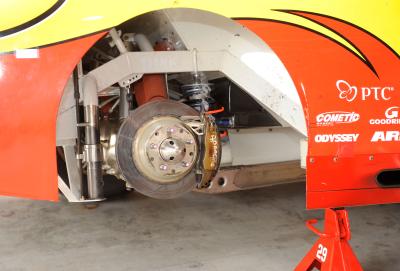
Brembo makes high-performance brakes for road and track. Lamborghini, Alfa Romeo, BMW, Chrysler, Mercedes, Nissan and Porsche are just some of the vehicle manufacturers that use Brembo-designed brakes. Unlike with conventional vehicles, you do not have to remove the caliper to install Brembo brake pads. The calipers are designed to quick release the pads, on track and road vehicles, which is one of the advantages of the Brembo system. Replacing the brake pads on a Brembo system will give you a first-hand look at this company's technology.
Loosen the wheel lug nuts from the position where you are going to replace the pads, using a jack. Raise the end of the vehicle with a jack. Place jack stands beneath the subframe or jack points, depending on the vehicle. Lower the vehicle onto the jack stands and remove the wheels completely.
Remove the brake pad tie-down cotter pins with pliers. Place the palm of your non-dominant hand over the retaining spring plate on the center rear of the caliper. Push the upper pad lock-down pin through the caliper, toward the center of the vehicle. Use a small screwdriver to push the pin through. Slowly lift your hand to release the tension on the spring plate. Remove the spring plate, then push the lower pin through and out of the caliper in the same manner as with the upper pin.
Pull up the brake pads individually, using needle-nose pliers on the small tabs protruding upward from the pads. Pull the pad from end to end, essentially wiggling the pad upward and out of the caliper. Remove each pad by hand once the pads become loose enough.
Wrap a flat-head screwdriver in a paper towel, and insert it between one of the caliper pistons, and the rotor. Gently pry the caliper pistons inward on the caliper. The Brembo calipers have four pistons, two on each side of the rotor. Switch back and forth between pistons on one side of the caliper, as every time you push one caliper piston in, the other will want to pop out again. Repeat the gently prying until all four pistons are retracted completely into the caliper.
Read the backing plate on the brake pad to see which position it is going into. Apply a generous portion of caliper grease onto the backing plate of the pad. Slide the brake pad downward into the caliper. Gently nudge the rotor opposite the caliper, if the pads get jammed. If the pads will not go in at all, remove the pad from the caliper completely and check the pistons to make sure they are not in the way. Install each brake pad individually. Do not use a hammer to push the pads in place.
Insert the bottom pad tie-down pin from the back of the caliper to the front. Tap the pin with a hammer until you line up the cotter pin hole between the brake pad end and the caliper. Insert the pad spring plate under the pin against the top of the brake pad. Bend the plate downward against the top of the pads and rotor completely. Install the upper pad tie-down pin and align cotter pin hole between the end of the brake pad and the caliper wall.
Insert the tie-down cotter pins between the upper ends of the brake pads and the caliper wall by hand. Make sure the cotter pin is lined up in each pad tie-down pin correctly.
Repeat Steps 2 through 7 to complete the pad replacement on the other side of the vehicle. Install the wheels back on the vehicle and tighten the lug nuts snug. Raise the vehicle off of the jack stands, then remove the stands from beneath the car. Lower the vehicle to the ground, and torque the wheels to the manufacturer's specifications with a 1/2-inch torque wrench and a socket.
Proceed to the driver's seat of the vehicle and pump the brakes several times. If the brake pedal does not stiffen after about five pumps, stop pumping and bleed the brake system.